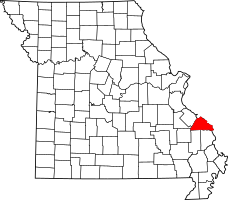Seventy-Six, Missouri facts for kids
Quick facts for kids
Seventy-Six, Missouri
|
|
|---|---|
|
Abandoned village
|
|

Location of Perry County, Missouri
|
|
| Country | United States |
| State | Missouri |
| County | Perry |
| Township | Brazeau |
| Elevation | 367 ft (112 m) |
| Time zone | UTC-6 (Central (CST)) |
| • Summer (DST) | UTC-5 (CDT) |
| ZIP code |
63775
|
| Area code(s) | 573 |
| FIPS code | 29-66782 |
| GNIS feature ID | 726217 |
Seventy-Six was a small, unincorporated community in Perry County, Missouri, United States. It was located in Brazeau Township, in the eastern part of the county. This community was about fourteen miles east of Perryville. It was also ninety miles south of Saint Louis. Seventy-Six was right on the banks of the mighty Mississippi River. Today, it is an abandoned village, meaning people no longer live there.
Contents
Why Was It Called Seventy-Six?
The name "Seventy-Six" has many interesting stories behind it. No one is completely sure which one is true!
Steamboat Stories
One popular idea comes from the great flood of 1844. A steamboat captain was sent to rescue people from the flood. He reportedly made 76 landings to help everyone. Another story says a steamboat captain used to say, "That beats all 76!" when he was annoyed. He said it so often at this particular landing that river workers started calling the spot "Seventy-Six."
Some people thought it was the 76th landing after leaving St. Louis. Another theory suggests the Government River Commission numbered river landings. This spot might have been number 76 from the start of the river's navigable (boat-friendly) waters. There's even a tale that the first captain to land his boat here was celebrating his 76th birthday.
Captain Wilkinson's Tale
According to Captain John Wilkinson, who later helped start the town, the name came from a shipwreck. In 1886, his boat hit something underwater and sank near the landing. It was the 76th landing on his trip. So, the town was named after this accident. Legend says Mr. Wilkinson put up a sign on the opposite river bank that read "76 LDG" (for landing).
The Story of Seventy-Six
Seventy-Six began as a busy spot where steamboats could stop along the Mississippi River.
How the Community Started
John Wilkinson, an immigrant from Yorkshire, England, came to the U.S. around 1816. He and his father invested in a riverboat called The Laurel. They started a shipping business. Their first trip went well, but on the way back, their ship sank a few miles from what would become Seventy-Six. After the accident, John Wilkinson was left with only the clothes he was wearing. He famously said, "Here is where I lost it and here is where I'll get it back."
From Shipwreck to Success
Wilkinson built a small shelter from the wreckage of The Laurel. He quickly started selling "cord wood." This was the main fuel for steamboats back then. At first, he used a hand sled or a wheelbarrow to move wood. Over time, he used small boats and then oxen and wagons. Eventually, Wilkinson became one of the biggest landowners in the area. An island in the Mississippi, Wilkinson Island, was named after him.
Life in Seventy-Six
The main business in Seventy-Six was the riverboat landing and selling wood. The community also had two schools for its children. There was a general store called "The G.S. Hatch Store." Other businesses included the Hatch Grain Company, fruit orchards, and a stockyard. The town also had a saloon, a hotel, and a post office (open from 1880 to 1957). A train depot was also present.
G.S. Hatch eventually owned most of the land in Seventy-Six. He ran the general store and the boat landing. He also had a large timber business and owned a big fruit orchard. Many people in Seventy-Six worked for him.
Churches in the Community
Seventy-Six was home to Shiloh Evangelical-Lutheran Church. It was started in 1857. Presbyterian church services were held on the second floor of the G.S. Hatch General Store. A Reverend would ride his horse from Old Appleton to lead these services. Baptisms were held in a creek about a mile outside of town.
The Railroad Arrives
In 1903, the St. Louis–San Francisco Railway built a railroad along the river. This made river travel less important. Trains stopped twice a day, every day. The rail service also attracted the attention of Jack "Quail Hunter" Kennedy. He was known as the last member of the Jesse James gang.
The Train Robbery Attempt
In October 1922, Jack Kennedy and his group tried to rob a St. Louis-San Francisco train. This happened just outside Seventy-Six. They were trying to steal money packages meant for a bank in Memphis, Tennessee. However, one of Kennedy's partners was actually an undercover Federal Marshall. The train's crew knew about the planned robbery. The attempt was stopped, and the robbers were caught.
The End of Seventy-Six
After many floods and a big drop in river transport, the community slowly disappeared. By 1940, only 35 people lived there. The post office closed in 1957. By the late 1950s, most people had left. Today, trees and farmland cover the area where Seventy-Six once stood.
Seventy-Six Conservation Area
In 1990, the Missouri Department of Conservation took over the area. It became the Seventy-Six Conservation Area. This area is used to show how to manage forests and wildlife. It also has the Wilkinson Walking Trail, named after John Wilkinson.
Where Was Seventy-Six Located?
Seventy-Six was located along the Mississippi River. It was at the end of Missouri Route D. Even though the Mississippi River usually separates Missouri and Illinois, this part of the river is surrounded by Missouri on both sides. Wilkinson Island, which is shared by both Missouri and Illinois, is on the east side of the Mississippi River here.

